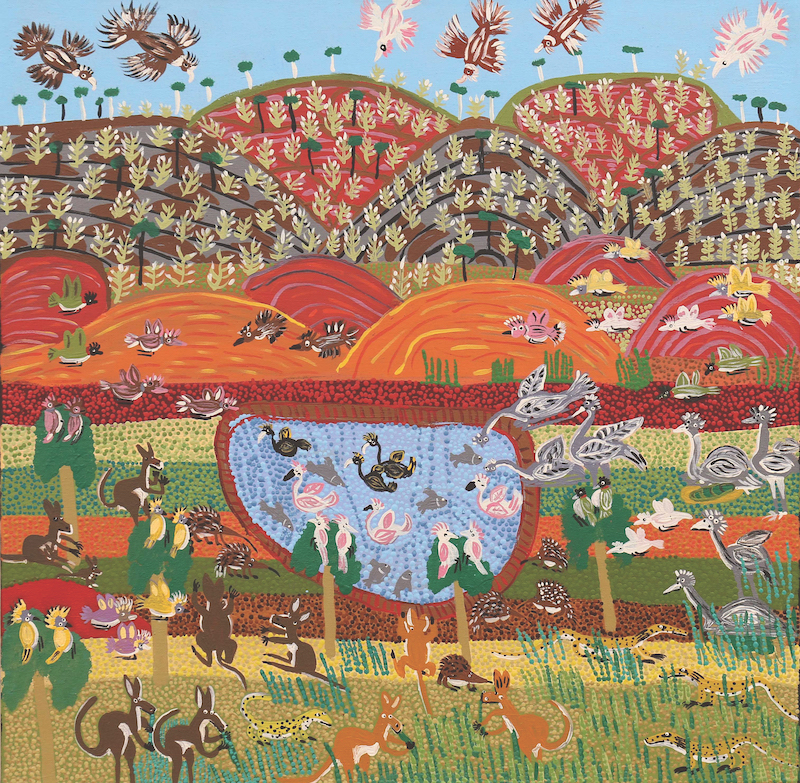ABOUT THIS YEAR’S AWARD
At Art Edit magazine, our mission since inception has been to help artists find new, appreciative audiences in the pages of this magazine and among Art Edit’s digital audiences. Yet so much of the artwork that crosses our desks every day deserves still wider recognition, most particularly from curators, gallery directors and public art institutions. Which is why, in October 2020, we launched The Art Edit Self-Represented Artist Award. Now in it’s second iteration, the award has seen winning and finalist artists gain recognition from industry leaders and contemporary art collectors.
This year’s prize attracted a vast array of incisive and creative interpretations of the theme Only Connect. “Only connect. Live in fragments no longer.” The term, coined by the English fiction writer E. M. Forster, informed our theme, inviting artists to respond to the moral importance of connection between individuals, across the barriers of race, class, and nation, while also commenting on the difficulty of connecting our personalities with our desires.
The response from artists was fantastic, the quality of the work and talent of the participating artists remarkable, and we left it to our panel of judges to make the final call.
We’re delighted to present the work of the winner of the second Art Edit Self-Represented Artist Award, Joanne Napangardi Wheeler, with Waterhole inside Palm Valley, 2021, an enchanting vision of ecological harmony within her Mparntwe/Alice Springs community.
The judges also highly commended artists Ida Sophia for her performance work, Regret, 2021, Liam Nunan for his painting Tommy Murphy, 2021, Betty Braedon for her grass sculpture Tjulpu (bird), 2021 and Ian Thomas for his work chandelier (from human finery), 2021.
And finally, special commendation was also awarded to the following artists: Alicia King, Sebastian Riffo Montenegro, Silvi Glattauer, Bianca Yrure, Michelle Bellamy, Monika Viktoria Diak, Ed Bechervaise, Claire Mooney, Elizabeth Lewis and Kirsten Sivyer.
WINNER
Joanne Napangardi Wheeler’s enduring connection to her culture and Country comes alive in her vibrant and tantalising works. Charlotte Middleton writes.
So animate is Joanne Napangardi Wheeler’s 2021 painting Waterhole inside Palm Valley, you can almost hear it. The screech of birds circling overhead, the splash of fish, the rustle of a reptile weaving its way through grasses – all this and more comes alive in the viewer’s imagination as we drink in the scene’s captivating detail.
“This is my family’s Country, they used to live there,” Wheeler explains of the desert setting. “There was a lot of water, and there was a good variety of bushtucker.” Harking back to the stories passed down by past generations, Wheeler’s depiction of an abundant paradise is testament to her enduring connection to culture, community, and most evidently, Country.
Like for so many of Australia’s Indigenous artists, painting runs in Wheeler’s blood. Born in 1969, the Western Arrernte-speaking painter is the great granddaughter of renowned watercolourist Albert Namatjira. Proud of her cultural and artistic lineage, Wheeler is resolved to uphold the legacy of her forebears: “I’m following the steps of my uncles and aunties, my mother and father, and the family. The Namatjiras.”
Painting out of Tangentyere Artists, Wheeler is one of around 400 artists making up the Aboriginal-owned Art Centre in Mparntwe/Alice Springs. “Joanne works alongside Indigenous artists from over ten different Central Desert language groups,” explains the Art Centre’s art coordinator Ruth McMillan. “There’s always lots of painting, seeing friends and family, cups of tea and yoyo biscuits.”
Wheeler’s work habitually focuses on her Country of Ntaria, Palm Valley, the Hermannsburg Community, Hermannsburg Mountain, and the Finke River – through different times and conditions, both past and present. Using acrylic paint on linen with brushes and punu (sticks), her painting style is characterised by confident mark-making and dynamic composition. The painter is also recognised for her knack in combining Tjukurrpa (the Pitjantjatjara term for The Dreaming) with personal historical narratives, contemporary figurative painting with traditional techniques, and stories from the past with those of the present.
“Joanne brings an innovative, figurative vernacular to central desert painting,” commented judge Thea Anamara Perkins about Waterhole inside Palm Valley. “The bright colours of the work hum with rhythmic energy. A holistic narrative with all its moving parts is presented within a flattened perspective – like the all-encompassing notion of Country.”
This latest accolade comes after a few very fruitful years for Wheeler. In 2020, she was named a joint winner in the Macquarie Group Emerging Artist Prize, and in 2021, she had an animation included in the group exhibition Animating Country as part of Tarnanthi Festival, Tarntanya/Adelaide. She was also selected as one of 14 finalists in the churchie emerging art prize 2021 at the Institute of Modern Art, Meanjin/Brisbane.
Most recently, Wheeler has finished work on a painting to be included in an International Women’s Day group exhibition at Vivien Anderson Gallery, Naarm/Melbourne, in March. As she continues to work towards another year of exhibiting work and submitting for prizes, the artist leaves us with plenty to ponder.
“Brimming with information and narrative, Waterhole inside Palm Valley employs the delicate usage of line and dot work to create a traditional foundation, with the playful overlay of contemporary figuration of wildlife from Joanne’s Country,” said judge Edward Woodley. “This is an artwork that continues to give, with every view.”
Uplifting as the desert scene is, the painting is all the more powerful for the sense of yearning for this kind of harmony and flourishing within the natural world that it encapsulates. “Our ancestors from Hermannsburg roamed around, long ago. They swam in the river, roamed far and wide, camping out. They used to paint,” says Wheeler. “And at Hermannsburg, the community in those times was good,” she added tellingly.
Waterhole inside Palm Valley offers an aspirational vision of what life might look like if we could learn, or rather re-learn, to connect – not just with the land, but with the past, with culture, and in so doing, with ourselves.
Quotes from Wheeler are translated to English from Western Arrernte.

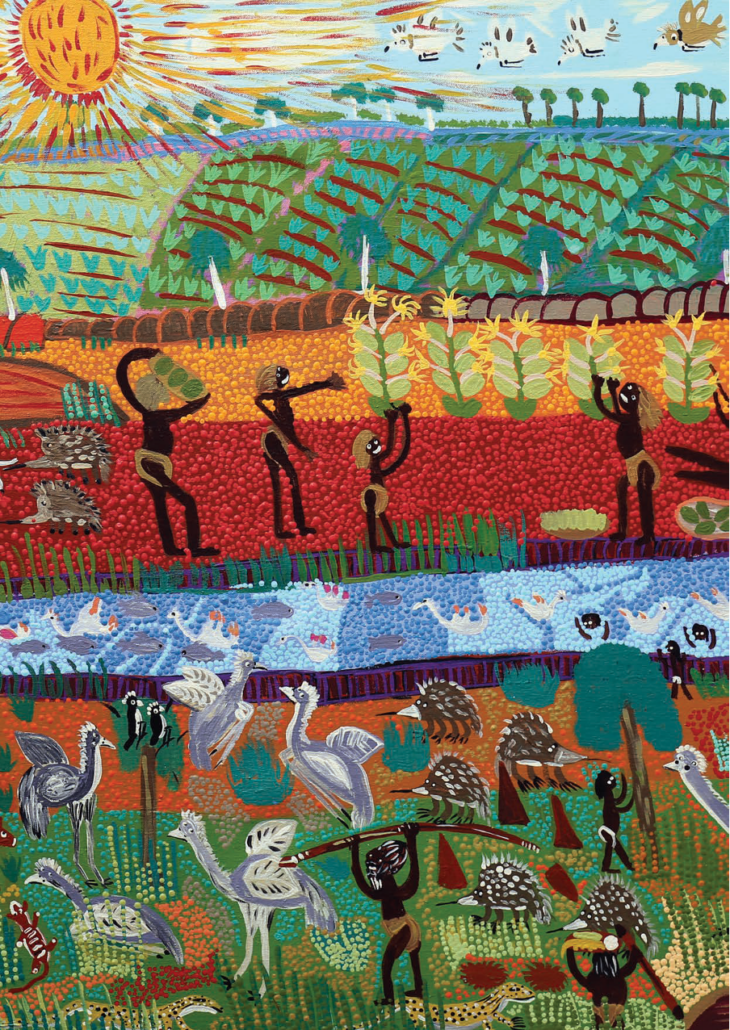

HIGHLY COMMENDED
Ida Sophia
“Regret is a reminder that when the solitary process of grief is shared with others, we can shed the heaviness,” commented judge Namila Benson of Ida Sophia’s performance piece Regret. Performed over 28 days for six hours each day, the piece addressed Sophia’s sense of regret about having been absent from her father’s side in his final month of life. The slow decomposition of an installation of flowers was devised to mirror the experience of watching disease overtake her father’s body. Affirming the transformative power of communal gestures, Sophia invited audiences to partake through contributing their own regrets, recorded on 1,000 weighted pieces of plaster serving as writing tablets that were physically attached to the artist. Carrying the symbolic weight of more than 500 participants’ regret(s), Sophia ritualistically cast off all burden on the final day, liberating both herself and each participant through an act of collective catharsis.
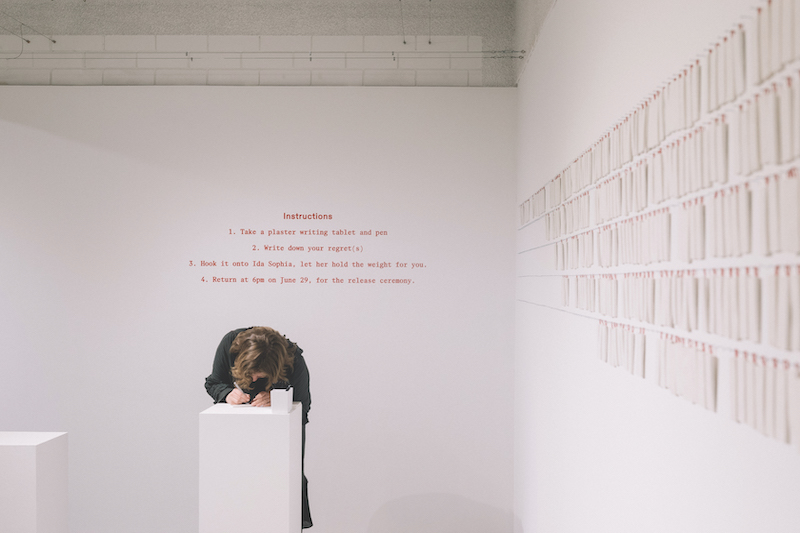
Liam Nunan
Liam Nunan’s portrait Tommy Murphy is a testament to the strength we can draw from remembering those we’ve shared a profound connection with. The painting takes Australian creative and vocal advocate for the 2017 marriage equality campaign, Tommy Murphy, as its subject. Tommy and fiancé Dane had been engaged for six years, before, four months after the plebiscite, Dane unexpectedly passed away. Over the next two years, Tommy rebuilt their home to Dane’s meticulous design specifications. “There is a beauty in Tommy living on, protected by the global chaos, in the home dreamed up by Dane,” said the artist. Nunan’s meditation on the relationship between love, grief, and the places they inhabit struck a chord with the judges. “The heartbreaking and poignant story of loss and reflection is captured in each stroke of Liam’s skilful portrait – a powerful piece that carries the weight of lost love and contemplation,” said Jono Fleming.
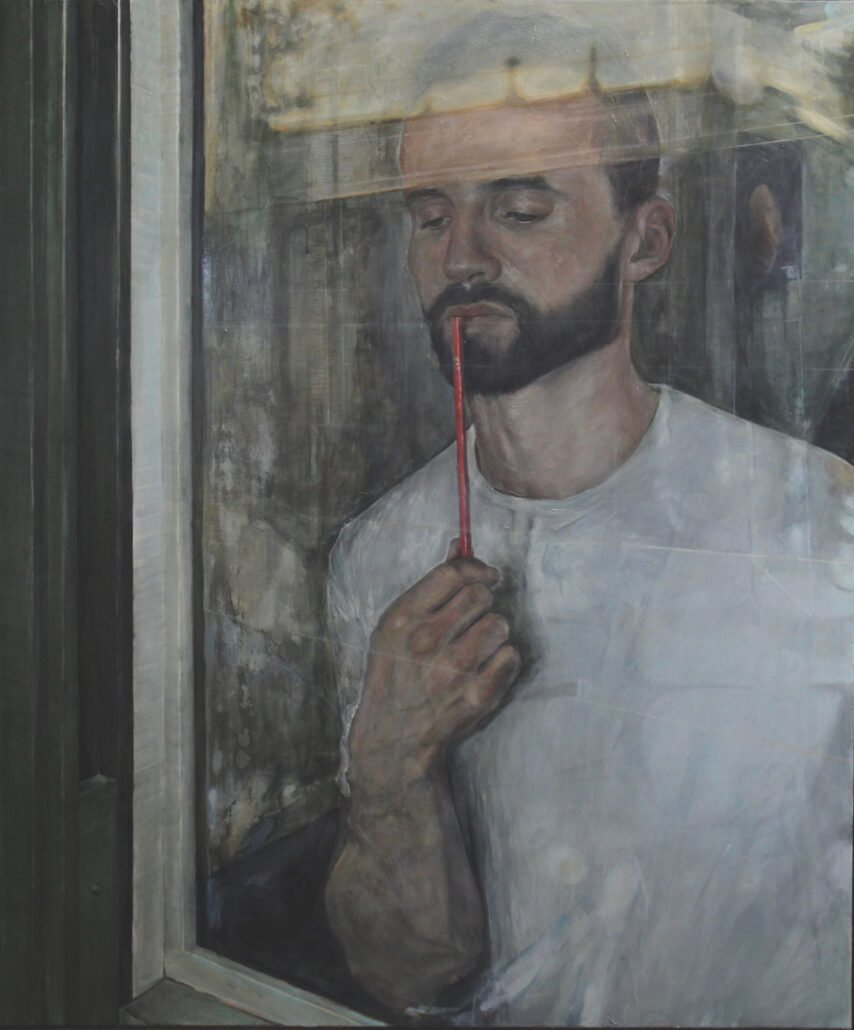
Betty Braedon
Tjulpu (bird) by Betty Braedon embodies the artist’s powerful ties to Country, family, and community. Working out of Tjanpi Art Centre alongside her mother and sisters, Braedon has developed her own unique style and approach to creating tjanpi (grass) birds. Seeking to capture the distinctive features and movements of different local species, her sculptures are fashioned from tjanpi collected on Country. “What makes it more interesting is our knowledge of these native plants – some are edible and some are not, so we choose grasses that are useful for art and sculpture,” explains the artist. Sharing ideas, complementing each other’s work, or pointing out mistakes, the group of artists maintain an important legacy: “it’s something positive that we can share with our children.” Judge Namila Benson notes, “there’s a lovely, elegant flow of movement to this bird/tjulpu. In terms of sustainability and reflecting Country, what a wonderful use of local plants and materials in Betty’s practice.”
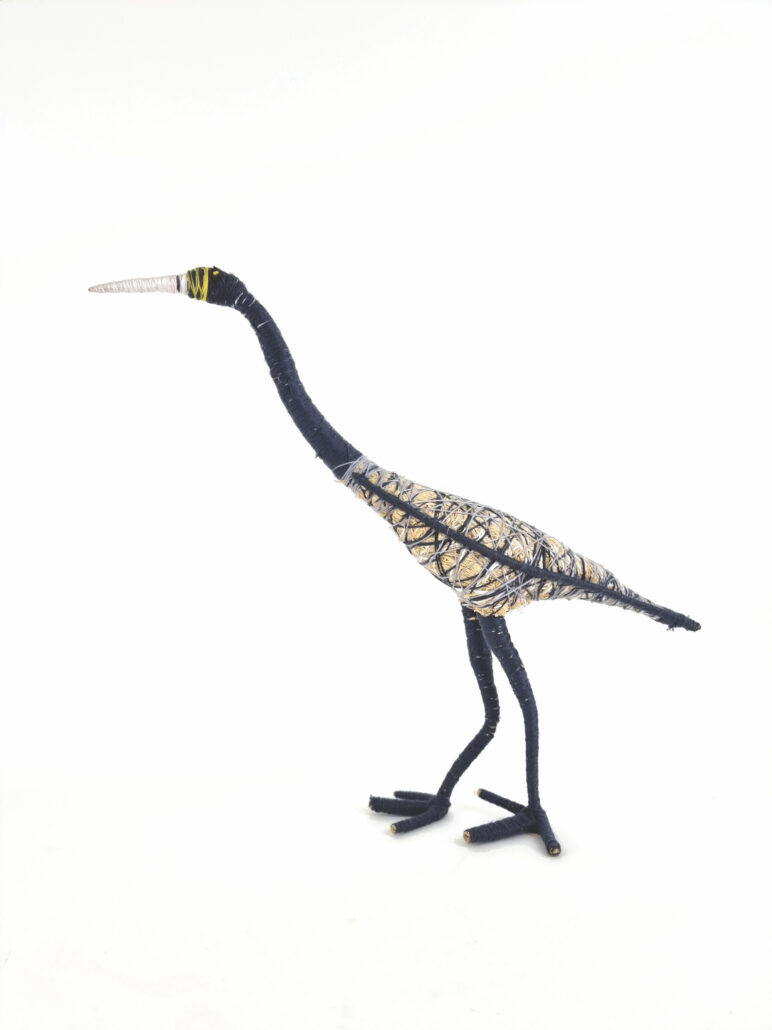
Ian Thomas
A tribute to his childhood love of sparkle, glamour and queer identity, Ian Thomas’ chandelier (from human finery) is an ode to rediscovering a sense of self. “It was inspired by memories of being a queer kid and the guilty pleasures of playing with my mother’s jewellery box,” Thomas says. Made from hundreds of crystals sourced from deconstructed chandeliers, the work is assembled on wire on board with a linen backing. “I like how they interconnect in a form that mirrors a patchwork quilt,” he says. “This connection of formerly disconnected elements removes them from their previous role and creates a new panorama of light, reflection, and celebration.” The judges were struck by Thomas’ playful shirking of societal expectations and of honouring one’s own identity. “The chandelier represents an antiquated world, and in turn has been lovingly mocked, and tactfully re-envisioned as a decorative matrix,” commented judge Edward Woodley. “The oversized 200 x 100cm linen board creates an impressive monument to the rebirth of self.”

JUDGE’S SPECIAL COMMENDATIONS











